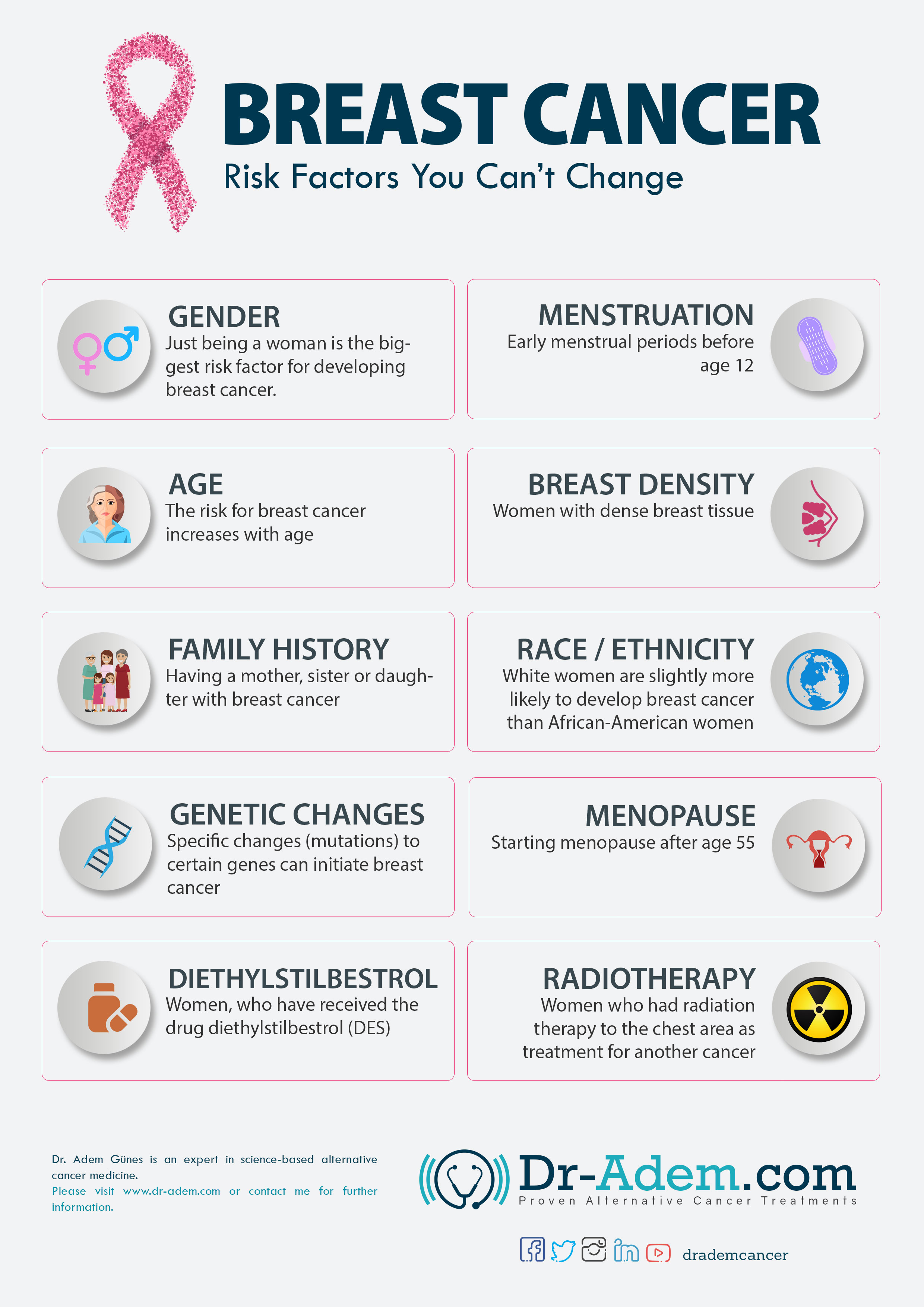Here’s the list of Major Risk Factors For Breast Cancer that you can’t change, but also there are many factors that you can control and be proactive about.

Embed this Infographic on your site:
<a href='https://dr-adem.com/major-risk-factors-for-breast-cancer/'><img src='https://dr-adem.com/wp-content/uploads/2019/10/breast-cancer-risk-factors-you-cant-change.jpg' alt='Major Risk Factors For Breast Cancer'/></a>- Gender
Just being a woman is the most significant risk factor for developing breast cancer. Men can also develop breast cancer but in a much less percentage. Only 1% of all the newly diagnosed cases belong to men. Women are more susceptible to it due to many factors. First of all, their breast has an entirely different anatomy than men’s, with fully formed glands. The cells in a woman’s breast are active and immature until she gets pregnant. This makes them very responsive to estrogen, in comparison to men who have very low levels of estrogen in their breast. - Age
The risk of developing breast cancer increases with your age. Most women develop breast cancer after age 50, and only 4 percent of all breast cancer patients are younger than 40. Also, 2 out of 3 invasive breast cancer cases appear in women older than 55 years old. The reason why, is that as we age, we expose ourselves to a greater chance for gene mutations, and the older we get, the harder it is to repair these DNA modifications. - Family History
Having a mother, sister, or daughter with breast cancer is doubling your risk of developing breast cancer. If two of them are positive for breast cancer, your risk gets 5 times higher. If you are familiar with breast cancer in your family, there are some [preventive steps] you can adopt in your daily life. - Genetic Changes
Specific changes (mutations) to certain genes can initiate breast cancer. About 5% to 10% of breast cancers caused by abnormal genes passed from parent to child. Mutations in the BRCA1 or BRCA 2 gene are the most common causes of hereditary breast cancer. Occasionally, an abnormal CHEK2 gene could also be responsible. You may consider a genetic test if you have a family history of breast cancer. - Diethylstilbestrol
Women who have received the drug diethylstilbestrol (DES). DES is a form of estrogen and was prescribed from the 1940s through the 1960s. The main indication was to prevent miscarriage, premature labor, and related complications of pregnancy.
Your cancer risk is higher than average if your mother used DES while she was pregnant with you. - Menstruation
Women who have their first menstrual periods before age 12 have a higher risk of breast cancer later in life. Their breasts started developing even before menstruation, meaning that immature and active cells interacted with hormones for long. Hormones disruptors and obesity seem to be responsible for earlier-than-normal menstruation. Also, the interval between menstruation and full-term pregnancy gets bigger. - Breast Density
Your breast density depends on the ratio between the breast tissue and fat tissue. Women with dense breast tissue have twice the risk of developing cancer. Besides, it is more difficult to detect breast cancer for mammograms. Dense breasts can be:
• Mostly fatty
• With scattered density
• With consistent density
• Extremely dense - Race / Ethnicity
White women have a higher risk of developing breast cancer than African-American women. Black women are more likely to develop more aggressive breast cancers, such as triple-negative breast cancer. However, lifestyle patterns and less access to medical care and screening seem to be boosting that risk in certain ethnicities. Therefore, improvements in these factors may change current statistics. - Menopause
Starting menopause after age 55. This is because of the broad exposure to estrogen, progesterone, and hormone disruptors for a longer time. When late menopause appears in the context of early menstruation, the risk becomes even higher. - Radiotherapy
Women who had radiation therapy at an age younger than 30 to the chest area or face have a higher risk of breast cancer. Radioactive iodine for thyroid disease may also increase the risk, but studies are inconclusive and mixed. Therefore, receiving radiation therapy for another cancer or acne in the past suggests you might be at higher-than-average risk for breast cancer.


